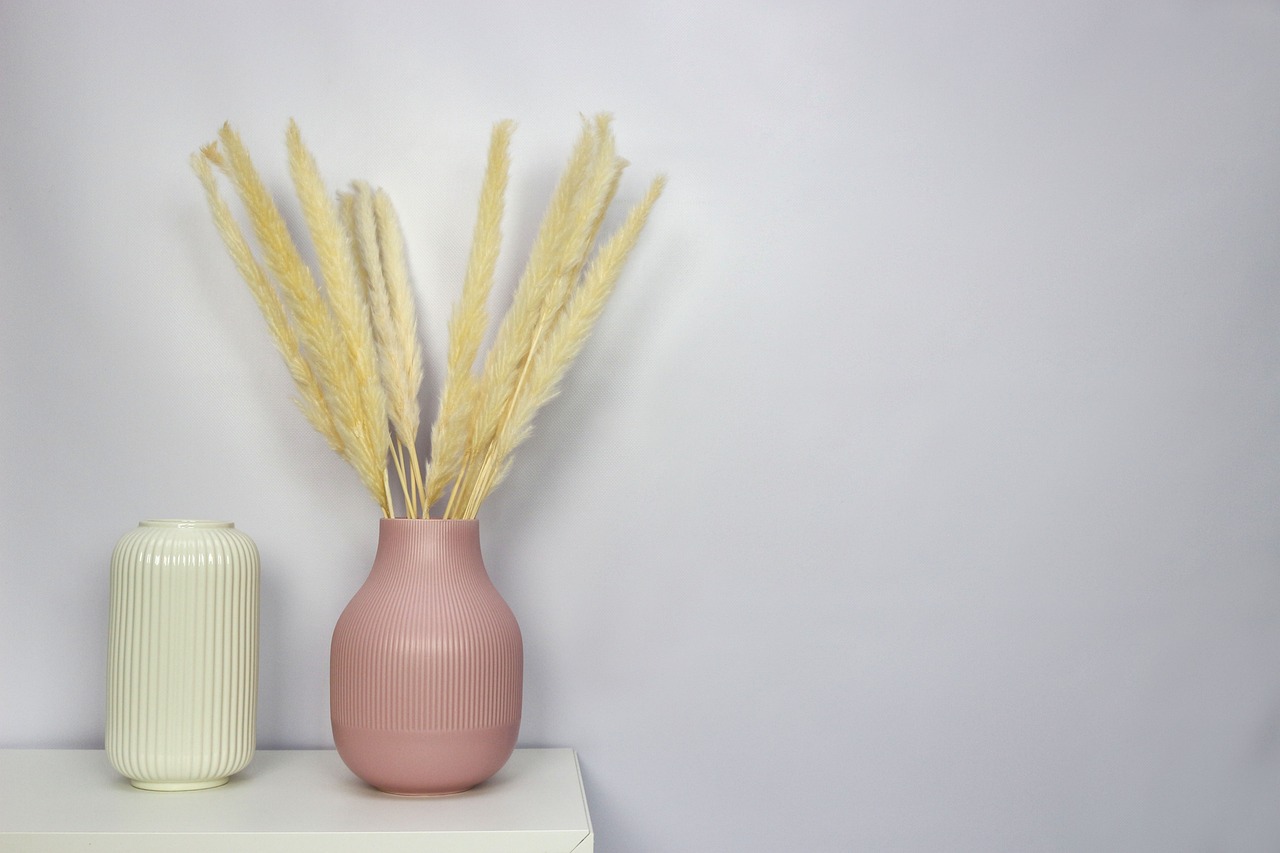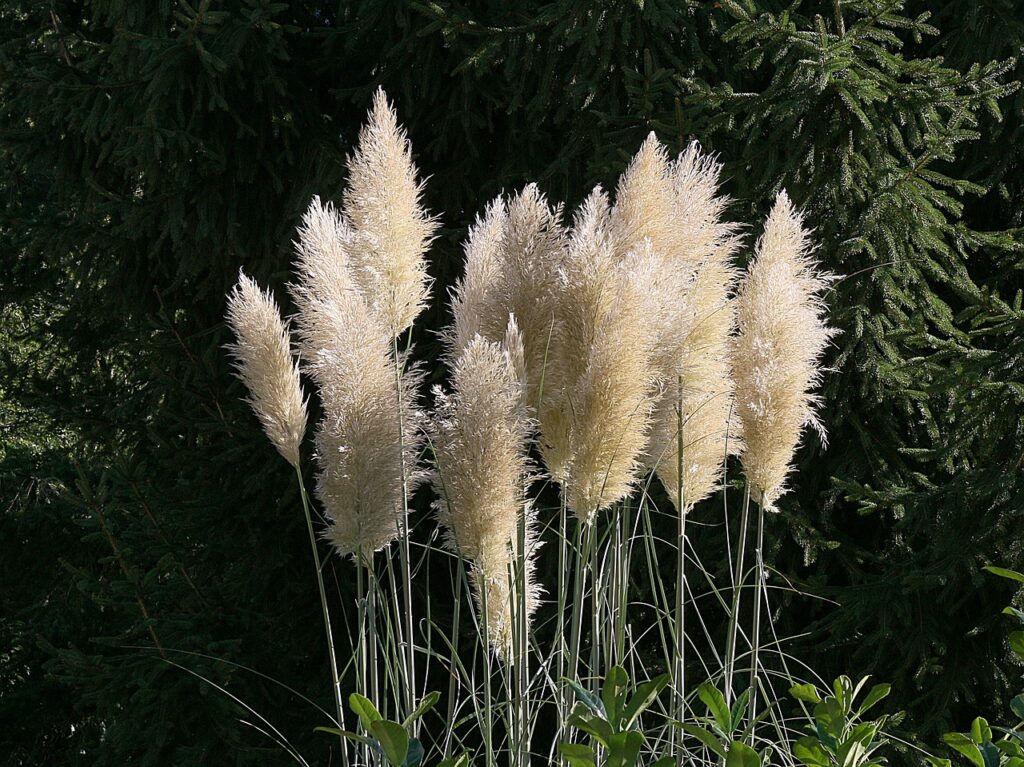
Pampas grass, with its ethereal beauty and remarkable adaptability, stands tall as a perennial favorite, captivating the imagination of designers and enthusiasts alike. In the realm of interior design and landscaping, trends come and go, but some elements withstand the test of time, effortlessly weaving their way into the fabric of our spaces.
Table of Contents
What is Pampas grass?
Pampas grass, scientifically known as Cortaderia Selloana, traces its origins to the sprawling landscapes of Brazil, Argentina, and Chile. A magnificent large perennial grass, it boasts a stature that can reach up to 10 feet when fully matured.
Its visual grandeur peaks during late summers when its signature silvery-white plumes gracefully ascend several feet above the foliage, creating a mesmerizing spectacle against any backdrop.

What makes Pampas an unparalleled phenomenon in the world of flora is its dual nature, manifesting as male and female flowers on separate plants. The female plants’ plumes, adorned with silky hairs enfolding tiny flowers, exude a fullness and splendor highly sought after for ornamental and decorative purposes.
These plumes, prized for their aesthetic appeal, are a coveted addition to indoor floral arrangements, beckoning designers to craft captivating displays that accentuate their inherent elegance.
The allure of Pampas extends far beyond its ornamental charm. Its practicality and ease of maintenance make it an ideal choice for both seasoned gardeners and novices venturing into botanical pursuits. One of the most alluring attributes of Pampas is its low-maintenance nature.
It thrives amidst neglect, requiring minimal intervention and care. Its ability to flourish sans regular watering or substantial sunlight endears it to individuals seeking greenery that complements their lifestyle with minimal upkeep.
Designers choice
Designers and homeowners alike cherish Pampas for its ability to imbue spaces with an air of tranquility and ease. Its feathery plumes evoke a sense of serenity, infusing rooms with a soft, calming texture that transforms the ambiance into one of effortless sophistication.
This inherent quality to evoke an easy, breezy, carefree feeling adds a touch of natural elegance to any environment, creating a harmonious balance between modern aesthetics and organic elements.
The versatility of Pampas is a key factor contributing to its unwavering popularity. Its applications span a wide array of settings, from adorning homes with its timeless beauty to embellishing wedding venues and bars, lending an understated yet distinctive touch to the décor.
Its presence seamlessly integrates into various design styles, be it minimalist, bohemian, or contemporary, elevating the visual appeal while maintaining an innate sense of understated elegance.
Where to buy Pampas Grass?
For those keen on acquiring Pampas , the avenues are not limited to traditional nurseries. While these florals do grow naturally in the wild, the urban landscape also hosts avenues to acquire these enchanting grasses.
In bustling cities like New York, a visit to the flower district on 28th street in Manhattan might unveil a treasure trove of botanical delights. Moreover, for the convenience of enthusiasts, numerous online platforms such as Amazon offer a commendable selection of Pampas grass arrangements, catering to individuals eager to incorporate this natural wonder into their living spaces.
As Pampas grass continues to reign supreme in the domain of décor trends, its appeal transcends mere fashion. It embodies timelessness and adaptability, effortlessly intertwining with the evolving tastes of design aficionados. Its enduring charm lies not only in its aesthetic allure but also in the feelings it evokes—the sense of calm, the touch of tranquility, and the ease it brings to spaces.
Pros & Cons of Pampas in Home Decor
Pros
i) Pampas grass adds a natural, bohemian elegance to interior spaces, bringing a touch of the outdoors inside. Its feathery plumes create a soft and stylish visual impact.
ii) It complements various interior design styles, from modern to bohemian, and can be incorporated into different rooms, including living spaces, bedrooms, and even bathrooms, enhancing the overall aesthetic.
iii) This grass provides texture and dimension to decor elements like vases, wall hangings, or centerpieces, adding depth and visual interest to the room.
iv) Pampas when dried can last for an extended period, making it a sustainable and long-lasting decorative element that doesn’t require frequent replacement.
v) Once dried, Pampas require minimal upkeep. It doesn’t need watering or sunlight, maintaining its appearance without much effort.
Cons
i) The plumes of Pampas can release pollen, potentially causing allergic reactions in sensitive individuals. Those with allergies should be cautious when using Pampas grass indoors.
ii) Pampas can shed small particles or plumes over time, requiring occasional cleaning. Additionally, its size might be overwhelming in smaller living spaces.
iii) Dry Pampas are highly flammable, posing a fire risk if placed near heat sources or open flames. Careful consideration of placement is necessary to avoid potential hazards.
iv) Over time, dried Pampas may lose some of its fluffiness or color, requiring replacement or refreshing to maintain its desired appearance.
Conclusion
Pampas grass stands as a testament to nature’s grace and resilience, a symbol of enduring beauty that transcends passing trends. Its ability to seamlessly merge with diverse design sensibilities while requiring minimal care underscores its status as a timeless decorative delight.
As we navigate an ever-evolving landscape of design preferences, the allure of Pampas grass remains unwavering, continuing to captivate hearts and elevate spaces with its ethereal presence.
Q. What is Pampas grass?
Pampas grass, scientifically known as Cortaderia Selloana, is a large perennial grass native to South America, particularly Brazil, Argentina, and Chile. It is renowned for its tall, feathery plumes that rise above its foliage, making it a popular choice for ornamental and decorative purposes.
Q. How tall does Pampas grass grow?
When fully matured, Pampas grass can reach impressive heights of up to 10 feet (3 meters) or even taller in some instances. Its stature makes it a striking addition to landscapes and gardens.
Q. What are the distinctive features of Pampas grass?
Pampas grass is characterized by its long, slender leaves and its most notable feature—the plumes. The silvery-white plumes emerge during late summer and can extend several feet above the foliage, imparting an ethereal and elegant appearance to the grass.
Q. Does Pampas grass require a lot of maintenance?
One of the appealing aspects of Pampas grass is its low-maintenance nature. Once established, it is relatively resilient and requires minimal care. It can thrive in various conditions and is adaptable to neglect, needing little water or sunlight to flourish.
Q. How do you care for Pampas grass?
Pampas is relatively easy to care for. It typically prefers well-drained soil and thrives in areas with full sunlight. Regular pruning is recommended to maintain its shape and prevent overgrowth. Additionally, removing dead or damaged foliage promotes its health and appearance.
Q. Can Pampas grass be grown indoors?
While Pampas is primarily an outdoor plant due to its size, its plumes are often used in indoor floral arrangements. However, growing it entirely indoors might be challenging due to its height and space requirements.
Q. Where can I buy Pampas grass?
Pampas can be found in nurseries, gardening centers, or botanical shops that specialize in ornamental plants. Additionally, it can sometimes be found growing wild in certain regions. Online retailers, such as Amazon, also offer a selection of Pampas grass arrangements for purchase.
Q. Is Pampas grass invasive?
In some regions, Pampas is considered invasive because of its ability to spread rapidly and outcompete native vegetation. It’s essential to check local regulations before planting it outdoors to prevent potential ecological issues.
Q. What are the uses of Pampas grass besides decoration?
Apart from its decorative purposes, Pampas has been historically used for thatching, making baskets, and even as feed for livestock due to its hardiness.
Q. Is Pampas grass toxic to pets?
Pampas can be mildly toxic to pets if ingested, leading to symptoms such as vomiting or mild digestive upset. It’s advisable to keep pets away from the plant to avoid potential health issues.